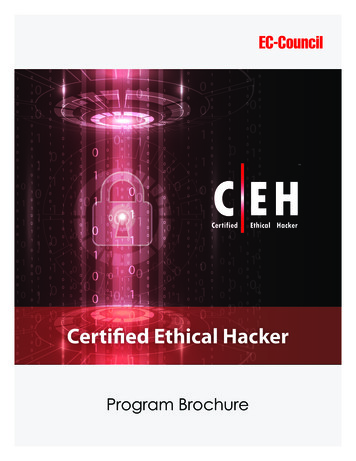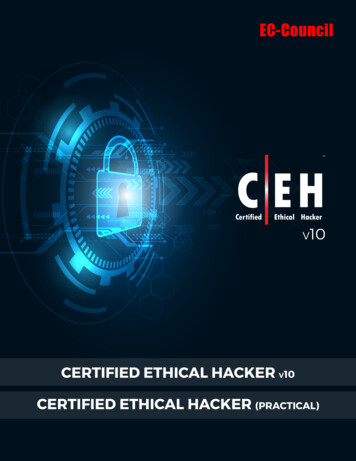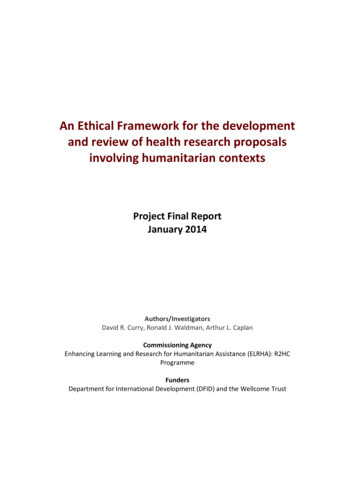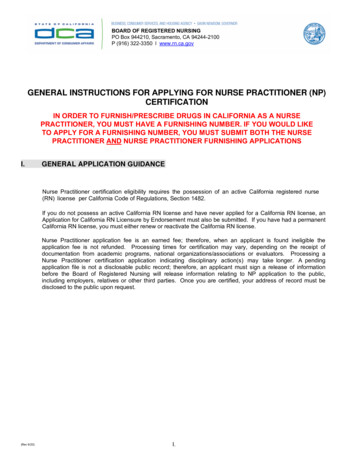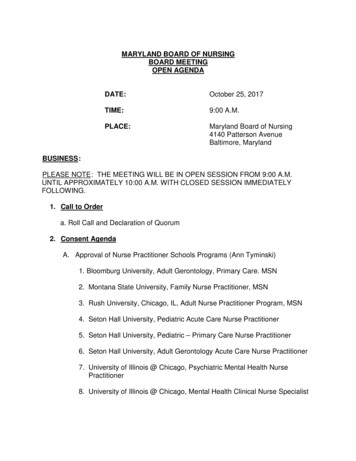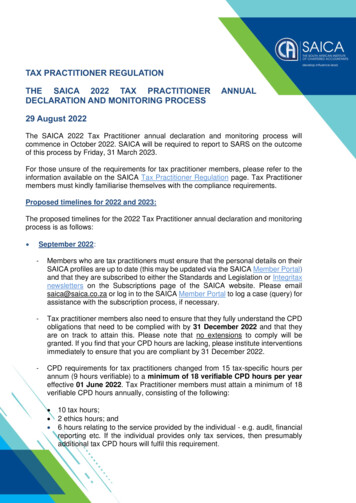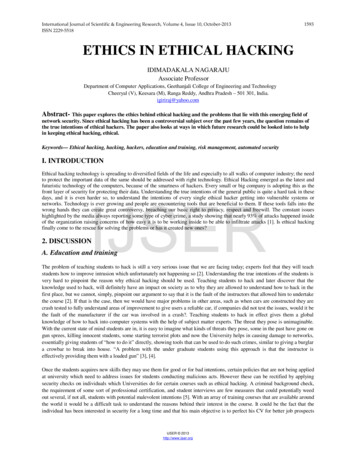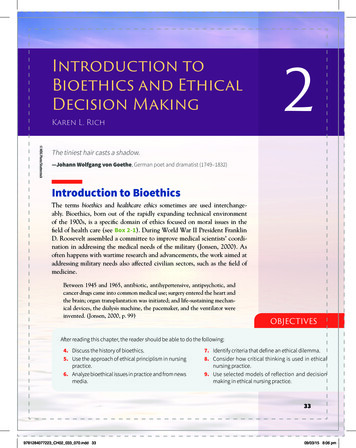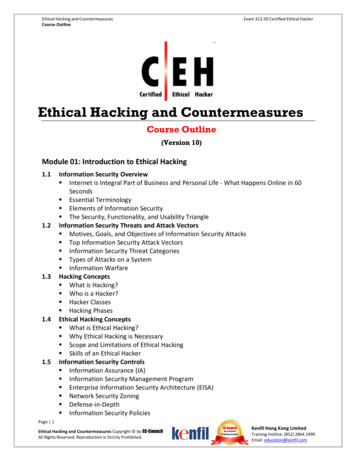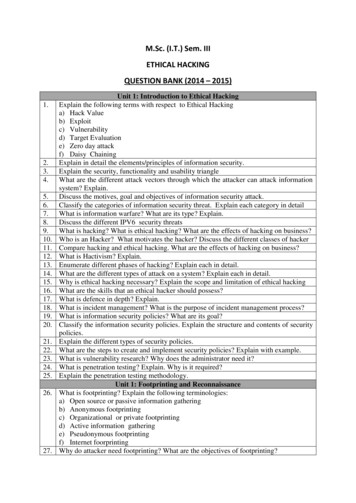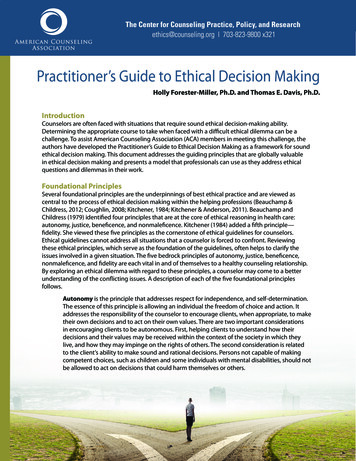
Transcription
American Counseling Association The Center for Counseling Practice, Policy, and ResearchThe Center for Counseling Practice, Policy, and Researchethics@counseling.org 703-823-9800 x321Practitioner’s Guide to Ethical Decision MakingHolly Forester-Miller, Ph.D. and Thomas E. Davis, Ph.D.IntroductionCounselors are often faced with situations that require sound ethical decision-making ability.Determining the appropriate course to take when faced with a difficult ethical dilemma can be achallenge. To assist American Counseling Association (ACA) members in meeting this challenge, theauthors have developed the Practitioner’s Guide to Ethical Decision Making as a framework for soundethical decision making. This document addresses the guiding principles that are globally valuablein ethical decision making and presents a model that professionals can use as they address ethicalquestions and dilemmas in their work.Foundational PrinciplesSeveral foundational principles are the underpinnings of best ethical practice and are viewed ascentral to the process of ethical decision making within the helping professions (Beauchamp &Childress, 2012; Coughlin, 2008; Kitchener, 1984; Kitchener & Anderson, 2011). Beauchamp andChildress (1979) identified four principles that are at the core of ethical reasoning in health care:autonomy, justice, beneficence, and nonmaleficence. Kitchener (1984) added a fifth principle—fidelity. She viewed these five principles as the cornerstone of ethical guidelines for counselors.Ethical guidelines cannot address all situations that a counselor is forced to confront. Reviewingthese ethical principles, which serve as the foundation of the guidelines, often helps to clarify theissues involved in a given situation. The five bedrock principles of autonomy, justice, beneficence,nonmaleficence, and fidelity are each vital in and of themselves to a healthy counseling relationship.By exploring an ethical dilemma with regard to these principles, a counselor may come to a betterunderstanding of the conflicting issues. A description of each of the five foundational principlesfollows.Autonomy is the principle that addresses respect for independence, and self-determination.The essence of this principle is allowing an individual the freedom of choice and action. Itaddresses the responsibility of the counselor to encourage clients, when appropriate, to maketheir own decisions and to act on their own values. There are two important considerationsin encouraging clients to be autonomous. First, helping clients to understand how theirdecisions and their values may be received within the context of the society in which theylive, and how they may impinge on the rights of others. The second consideration is relatedto the client’s ability to make sound and rational decisions. Persons not capable of makingcompetent choices, such as children and some individuals with mental disabilities, should notbe allowed to act on decisions that could harm themselves or others.Practitioner’s Guide to Ethical Decision Making 1
American Counseling Association The Center for Counseling Practice, Policy, and ResearchJustice, as Kitchener (1984) points out, is “treating equals equally and unequals unequallybut in proportion to their relevant differences” (p. 49). Justice does not mean treating allindividuals the same. If an individual is to be treated differently, the counselor needs tobe able to offer a rationale that explains the necessity and appropriateness of treating theindividual differently. An example of justice is that a counselor would give a person who isblind a form that is in braille, or would go through the form with that individual orally, insteadof giving him or her a standard written form to fill out. But the counselor would treat him orher the same as any other client in all other regards.Beneficence reflects the counselor’s responsibility to contribute to the welfare of theclient. Simply stated, it means to do good, to be proactive, and also to prevent harm whenpossible (Forester-Miller & Rubenstein, 1992). Beneficence can come in many forms, such asprevention and early intervention actions that contribute to the betterment of clients.Nonmaleficence is the concept of not causing harm to others. Often explained as “above all,do no harm,” this principle is considered by some to be the most critical of all the principles,even though theoretically they are all of equal weight (Kitchener, 1984; Rosenbaum, 1982;Stadler, 1986). This principle reflects both the idea of not inflicting intentional harm, and notengaging in actions that risk harming others (Forester-Miller & Rubenstein, 1992). Weighingpotential harm against potential benefits is important in a counselor’s efforts towardensuring “no harm.”Fidelity involves the notions of loyalty, faithfulness, and honoring commitments. Clientsmust be able to trust the counselor and have faith in the therapeutic relationship if growth isto occur. Therefore, the counselor must take care not to threaten the therapeutic relationshipor to leave obligations unfulfilled.When exploring an ethical dilemma, the counselor needs to examine the situation and how each ofthe above principles may apply to that particular case. At times, this examination alone will clarifythe issues so that the means for resolving the dilemma becomes clear. When an initial review of thefive foundational principles does not provide direction, it is helpful to be able to work through thesteps of an ethical decision-making model. The following sections describe the steps of the ethicaldecision-making model.Ethical Decision-Making ModelWe have incorporated the work of Forester-Miller and Rubenstein (1992), Haas and Malouf (1989),Kitchener (1984), Stadler (1986), and Van Hoose and Paradise (1979) into a practical, sequential,seven-step, ethical decision-making model. A description and discussion of the steps follow. Weencourage counselors to consider the worldview of their clients and others who may be affected ineach step of the decision-making model (Luke, Goodrich, & Gilbride, 2013).1. Identify the problem.Gather as much information as you can that will illuminate the situation. In doing so, it isimportant to be as specific and objective as possible. Writing ideas on paper often helpsprovide clarity. Outline the facts, separating out innuendos, assumptions, hypotheses, orsuspicions. There are several questions to ask yourself: Is it an ethical, legal, professional, orclinical problem? Is it a combination of more than one of these? If a legal question exists, besure to seek legal advice.Other questions that may be useful to ask yourself are: Is the issue related to me and whatI am or am not doing? Is it related to a client and/or the client’s significant others and whatthey are or are not doing? Is it related to technology in the provision of services or of storingPractitioner’s Guide to Ethical Decision Making 2
American Counseling Association The Center for Counseling Practice, Policy, and Researchrecords? Is it related to the institution or agency and their policies and procedures? If theproblem can be resolved by implementing a policy of an institution or agency, you can lookto the agency’s guidelines. It is important to remember that the dilemmas counselors faceare often complex; therefore, a useful guideline is to examine the problem from severalperspectives and avoid searching for an overly simplistic solution.2. Apply the ACA Code of Ethics.After having clarified the problem, refer to the ACA Code of Ethics (ACA, 2014) to see if theissue is addressed. Also consider any other state or professional codes that may apply toyou (Bradley & Hendricks, 2008; Brennan, 2013). When reviewing the ethical codes, be sureto consider any multicultural perspectives of the particular case (Frame & Williams, 2005).Remember to examine all the nuisances that exist when technology is involved. If there is anapplicable standard or several standards and they are specific and clear, following the courseof action indicated should lead to a resolution of the problem. To be able to apply the ethicalstandards, it is essential that you have read them carefully and that you understand theirimplications.If the problem is not resolved by reviewing the ACA Code of Ethics, then you have a complexethical dilemma and need to proceed with further steps in the ethical decision-makingprocess (Bradley & Hendricks, 2008; Forester-Miller & Davis, 1996). Levitt, Farry, and Mazzarella(2015) indicated that decision-making models can be time consuming. If it is a complexethical dilemma, then you should take time to thoroughly analyze and assess all aspects ofthe situation and its potential solutions3. Determine the nature and dimensions of the dilemma.There are a few steps to follow to ensure that you have examined the problem in all of itsvarious dimensions: Examine the dilemma’s implications for each of the foundational principles: autonomy,justice, beneficence, nonmaleficence, and fidelity. Decide which of the principles applyto the specific situation, and determine which principle takes priority for you in thiscase. In theory, each principle is of equal value, which means that you will need to useyour professional judgment to determine the priorities when two or more of them are inconflict. Review the relevant professional literature to ensure that you are using the most currentprofessional thinking and are aware of the diversity issues involved in the particularsituation. Consult with experienced professional counselors and/or supervisors who also abide bythe ACA Code of Ethics. As they review with you the information you have gathered, theymay help you to see other issues that are relevant or provide a perspective you have notconsidered. They may also be able to identify aspects of the dilemma that you are notviewing objectively. Consult your state or national professional associations to see if they can provide help withthe dilemma.Practitioner’s Guide to Ethical Decision Making 3
American Counseling Association The Center for Counseling Practice, Policy, and Research4. Generate potential courses of action. Brainstorm as many potential courses of action as possible. Be creative and list all of theoptions you can think of, even ones that you are not sure will work. In this brainstorming phase, you want to generate as many potential solutions as possible.Do not worry about judging and eliminating solutions; you will evaluate them in the nextstep. Whenever possible, consult with at least one colleague who subscribes to the ACA Code ofEthics to help you generate options.5. Consider the potential consequences of all options and determine a course of action. Considering the information you have gathered and the priorities you have set, evaluateeach option, being sure to assess the potential consequences for all of the parties involved.Ponder the implications of each course of action for the client, for others who will beaffected, and for yourself as a counselor. Eliminate the options that clearly do not give the desired results or that cause even moreproblematic consequences. Review the remaining options to determine which option or combination of options bestfits the situation and addresses the priorities you have identified.6. Evaluate the selected course of action. Review the selected course of action to see if it presents any new ethical considerations. Apply three simple tests to the selected course of action to ensure that it is appropriate:justice, publicity, and universality (Stadler, 1986).Justice: In applying the test of justice, assess your own sense of fairness by determiningwhether you would treat others the same in this situation.Publicity: For the test of publicity, ask yourself whether you would want your behaviorreported in the press.Universality: The test of universality asks you to assess whether you could recommend thesame course of action to another counselor in the same situation. If the course of action you have selected causes any new ethical issues, then you’ll needto go back to the beginning and reevaluate each step of the process. Perhaps you havechosen the wrong option or you might have identified the problem incorrectly. If you can answer in the affirmative to each of the questions suggested by Stadler (1986;thus passing the tests of justice, publicity, and universality) and you are satisfied thatyou have selected an appropriate course of action, then you are ready to move on toimplementation.7. Implement the course of action. Strengthen your resolve to allow you to carry out your plan. Just because it is the rightdecision does not mean it will be easy to implement. Taking the appropriate action in anethical dilemma is often difficult. After implementing your course of action, it is good practice to follow up on the situationto assess whether your actions had the anticipated effect and consequences.Practitioner’s Guide to Ethical Decision Making 4
American Counseling Association The Center for Counseling Practice, Policy, and ResearchThe Ethical Decision-Making Model at a Glance1. Identify the problem.2. Apply the ACA Code of Ethics.3. Determine the nature and dimensions of the dilemma.4. Generate potential courses of action.5. Consider the potential consequences of all options and determine a course of action.6. Evaluate the selected course of action.7. Implement the course of action.ConclusionIt is important to realize that different professionals may choose different courses of action for thesame situation. There is rarely one right answer to a complex ethical dilemma. However, if you followa systematic model, you can be assured that you will be able to give a professional explanation forthe course of action you chose. You should always document your decision-making process in theclient file (Brennan, 2013). Van Hoose and Paradise (1979) suggest that a counselor “is probablyacting in an ethically responsible way concerning a client if (1) he or she has maintained personal andprofessional honesty, coupled with (2) the best interests of the client, (3) without malice or personalgain, and (4) can justify his or her actions as the best judgment of what should be done based uponthe current state of the profession” (p. 58). Following this model will help to ensure that all four ofthese conditions have been met.ReferencesAmerican Counseling Association (2014). Code of Ethics. Alexandria, VA: Author.Barnett, J. E., & Johnson, W. B. (2015). Ethics desk reference for counselors (2nd ed.). Alexandria, VA:American Counseling Association.Beauchamp, T., & Childress, J. F. (1979). Principles of biomedical ethics. New York, NY: Oxford UniversityPress.Beauchamp, T. L., & Childress, J. F. (2012). Principles of biomedical ethics (7th ed.). New York, NY: OxfordUniversity Press.Bradley, L. J., & Hendricks, C. B. (2008). Ethical decision making: Basic issues. The Family Journal, 16,261–263.Brennan, C. (2013). Ensuring ethical practice: Guidelines for mental health counselors in privatepractice. Journal of Mental Health Counseling, 35, 245–261.Coughlin, S. (2008). How many principles for public health ethics? The Open Public Health Journal, 1,8–16.Forester-Miller, H., & Davis, T. (1996). A practitioner’s guide to ethical decision making. Alexandria, VA:American Counseling Association.Forester-Miller, H., & Rubenstein, R. L. (1992). Group counseling: Ethics and professional issues.In D. Capuzzi & D. R. Gross (Eds.), Introduction to group counseling (2nd ed., pp. 307–323).Denver, CO: Love.Frame, M. W., & Williams, C. B. (2005) A model of ethical decision making from a multiculturalperspective. Counseling and Values, 49, 165–179.Haas, L. J., & Malouf, J. L. (1989). Keeping up the good work: A practitioner’s guide to mental health ethics.Sarasota, FL: Professional Resource Exchange.Kitchener, K. S. (1984). Intuition, critical evaluation and ethical principles: The foundation for ethicaldecisions in counseling psychology. Counseling Psychologist, 12, 43–55.Practitioner’s Guide to Ethical Decision Making 5
American Counseling Association The Center for Counseling Practice, Policy, and ResearchKitchener, K. S., & Anderson, S. K. (2011). Foundations of ethical practice, research, and teaching inpsychology and counseling (2nd ed.). New York, NY: Routledge.Levitt, D. H., Farry, T. J., & Mazzarella, J. R. (2015). Counselor ethical reasoning: Decision-makingpractice versus theory. Counseling and Values, 60, 84–99.Luke, M., Goodrich, K. M., & Gilbride, D. D. (2013). Intercultural model of ethical decision making:Addressing worldview dilemmas in school counseling. Counseling and Values, 58, 177–194.Rosenbaum, M. (Ed.). (1982). Ethics and values in psychotherapy: A guidebook. New York, NY: Free Press.Stadler, H. A. (1986). Making hard choices: Clarifying controversial ethical issues. Counseling andHuman Development, 19, 1–10.Van Hoose, W. H., & Paradise, L. V. (1979). Ethics in counseling and psychotherapy: Perspectives in issuesand decision making. Cranston, RI: Carroll.CitationForester-Miller, H., & Davis, T. E. (2016). Practitioner’s guide to ethical decision making (Rev. ed.).Retrieved from pdfPractitioner’s Guide to Ethical Decision Making 6
If the problem is not resolved by reviewing the ACA Code of Ethics, then you have a complex ethical dilemma and need to proceed with further steps in the ethical decision-making process (Bradley & Hendricks, 2008; Forester-Miller & Davis, 1996). Levitt, Farry, and Mazzarella (2015) indicated that decision-making models can be time consuming.
